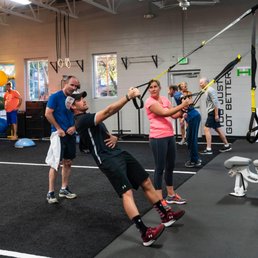
It can be very embarrassing to see people make poor choices on the fitness equipment. Many people use incorrect form while lifting weights. Even the most experienced of gym goers can make these errors. Even minor mistakes can cause big problems during your workout. This is why it is so important to practice proper form and technique. These errors can be avoided. If you aren't sure, seek professional assistance.
Over-lifting is one of the most common mistakes in the gym. This is a serious mistake and is most often committed by men. This can be attributed to their inflated sense of capability or an ego. One reason could be a desire for women to admire them. It's a good idea start with lighter weights, and gradually increase your lifting. This will improve your training and prevent injuries which can lead to lost time.

Beginers should not skip warm-up. Skipping the warm up can not only slow down progress but also cause injury. Warming up is a good way to increase body temperature, boost blood flow, reduce heart rate, relax muscles, and help with joint pain. The warm-up is important because it can cause long-lasting pain in your joints. It is important to be aware of common gym errors and avoid them.
Insufficient rest between sets is a common error. Most people make this mistake when they are lifting weights. They don't allow themselves to rest for five to ten minutes between sets and exercises. They will have difficulty completing a set and may not be able to keep their form. If you don't take the right amount of rest between exercises and sets, your body will not be able to recover fully. Injuries happen when you exercise. Make sure to study proper form.
The most common mistake a beginner makes in the gym is using the wrong technique. This is one of the biggest mistakes made in a gym. This is a mistake that beginners should avoid. If you aren't sure what to try, don’t be afraid asking for help. The right technique will prevent you from getting hurt. This will ensure that your exercise is safe and efficient. It's easier to see results when you do it correctly.

A fitness professional is recommended if you are looking to lose weight. A fitness specialist will evaluate your personal needs and develop a custom exercise plan. A great personal trainer will have a plan and encourage you to lift more weight. It is important that you know what kind of exercises are needed to get the desired result. You can also get help from a trainer to ensure that you are safe and effective.
FAQ
What is the difference among a virus or a bacterium and what are their differences?
A virus is a microscopic organism that cannot reproduce outside its host cell. A bacterium can be described as a single-celled organism which reproduces by splitting in two. Viruses have a very small size (about 20 nanometers), while bacteria is larger (up to one micron).
Viruses are usually spread through contact with infected bodily fluids, including saliva, urine, semen, vaginal secretions, pus, and feces. Bacteria can easily be spread from direct contact to contaminated surfaces and objects.
Viruses can enter our bodies through cuts, scrapes, bites, or other breaks in the skin. They may also get into the body through the nose and mouth, eyes, ears or rectum.
Bacteria can enter our bodies through wounds, cuts, scrapes, burns, insect stings, or other breaks in our skin. They can also enter our bodies from food, water, soil, dust, and animals.
Viruses and bacteria both cause illness. But viruses do not have the ability to multiply within their hosts. Viral infections can only cause diseases in living cells.
Bacteria can multiply within their hosts and cause illness. They can invade other areas of the body. That's why we need antibiotics to kill them.
Here are five ways to lead a healthy lifestyle.
Healthy lifestyles include eating right, exercise regularly, getting enough rest, managing stress, having fun, and eating healthy. Eating well means avoiding processed foods, sugar, and unhealthy fats. Exercise helps burn calories and strengthens muscles. Getting enough sleep improves memory and concentration. Stress management is a way to reduce anxiety levels and depression. Fun keeps us vibrant and young.
How does weight change with age?
How do you determine if your bodyweight is changing?
If there are less calories than muscle mass, then weight loss is possible. This means that calories must be consumed at a rate greater than energy. Reduced activity is the leading cause of weight gain. Other factors include stress, illness and pregnancy. A person who has more fat than their muscle mass will experience weight gain. It occurs when people eat more calories than what they use in a given day. There are many reasons for this, including overeating and increased physical activity.
The primary reason we lose weight is that we consume less calories than what we burn. When we exercise regularly, we increase our metabolism rate which burns off more calories throughout the day. But, this does not mean that we will be thinner. It is important to know if we are losing weight or gaining muscle. If we are burning more calories than what we eat, then we will lose weight. But, if we consume far more calories than what we burn, then we actually store them as fat.
As we age, our ability to move around is slower and we are less mobile. We also tend eat less than we used to. As a result, we gain weight. On the other hand, we have more muscle mass and look larger than we actually are.
If you don't weigh yourself every week, it's impossible to determine how much weight has been lost. There are many methods to measure your weight. You can check your waist size, your hips, your thighs, your arms, etc. Some people prefer to use bathroom scales while others like to use tape measures.
For a better track of your progress, try to weigh yourself once per week and measure your waistline once every month. You can also take pictures of yourself every few months to see how far you've come.
Online, you can find out your height and weight. For example, if you're 5'10" tall and weigh 180 pounds, you'd probably weigh 180 pounds.
How much should I weigh for my height and age? BMI calculator and chart
Use a BMI calculator to determine how much weight is needed to lose. The range of a healthy BMI is between 18.5- 24.9. Weight loss is possible if you aim to lose approximately 10 pounds per week. Simply enter your height, weight and desired BMI into the BMI calculator to calculate it.
To see if you're overweight or obese, check out this BMI chart.
What are 10 healthy habits you can adopt?
-
Eat breakfast every day.
-
Don't skip meals.
-
Maintain a balanced diet.
-
Drink plenty of water
-
Take care of your body.
-
Get enough rest.
-
Avoid junk food.
-
Get at least one form of exercise each day.
-
Have fun
-
Find new friends
Statistics
- According to the 2020 Dietary Guidelines for Americans, a balanced diet high in fruits and vegetables, lean protein, low-fat dairy and whole grains is needed for optimal energy. (mayoclinichealthsystem.org)
- In both adults and children, the intake of free sugars should be reduced to less than 10% of total energy intake. (who.int)
- WHO recommends consuming less than 5% of total energy intake for additional health benefits. (who.int)
- nutrients.[17]X Research sourceWhole grains to try include: 100% whole wheat pasta and bread, brown rice, whole grain oats, farro, millet, quinoa, and barley. (wikihow.com)
External Links
How To
What does the "vitamins” word mean?
Vitamins are organic substances found naturally in food. Vitamins aid us in absorbing nutrients from the food we eat. Vitamins are not made by the body, so they must be obtained through food.
There are two types vitamins: water soluble or fat soluble. Water-soluble vitamins dissolve quickly in water. These include vitamin C (thiamine), Vitamin B1 (riboflavin), Vitamin B2 (riboflavin), Vitamin B3 (niacin), Vitamin B6 (pyridoxine), Vitamin C, B1 (thiamine), Vitamin B2 (riboflavin), Vitamin B3 (niacin), and Vitamin B6 (pyridoxine). Fat-soluble vitamins are stored in the liver, fatty tissue and kidneys. These include vitamin D, E and K, as well as beta carotene.
Vitamins are classified based on their biological activity. There are eight major vitamin groups:
-
A – Essential for normal growth, and the maintenance of good health.
-
C - important for proper nerve function and energy production.
-
D - necessary for healthy bones and teeth.
-
E is necessary for good vision, reproduction.
-
K - essential for healthy muscles, nerves, and bones.
-
P - essential for strong bones, teeth and tendons
-
Q - Aids in digestion and absorption.
-
R - Red blood cells are made from red blood cells.
The recommended daily intake (RDA), of vitamins varies with age, gender and physical condition. The U.S. Food and Drug Administration (FDA) sets the RDA values.
For adults aged 19 and older, the RDA for vitamin B is 400 micrograms daily. However, pregnant women need 600 micrograms per day because it is important for fetal development. Children ages 1-8 require 900 micrograms per day. For infants younger than one year, 700 micrograms are required daily. However, this number drops to 500 micrograms each day for children aged 9-12 months.
Children aged 1-18 years need 800 micrograms daily, while children overweight require 1000 micrograms per days. Children who are severely obese or underweight will need 1200 micrograms each day.
Children between 4 and 8 years old with anemia will need 2200 micrograms daily of vitamin C.
2000 micrograms daily is required for adults over 50 to maintain their general health. Breastfeeding or pregnant women require 3000 micrograms per daily due to higher nutrient demands.
1500 micrograms is the recommended daily intake for adults aged 70+, who lose approximately 10% of muscle each year.
Women who are pregnant or nursing need more than the RDA. Pregnant mothers need 4000 micrograms per daily during pregnancy and 2500 after giving birth. Breastfeeding mothers need to consume 5000 micrograms every day when breastmilk has been produced.